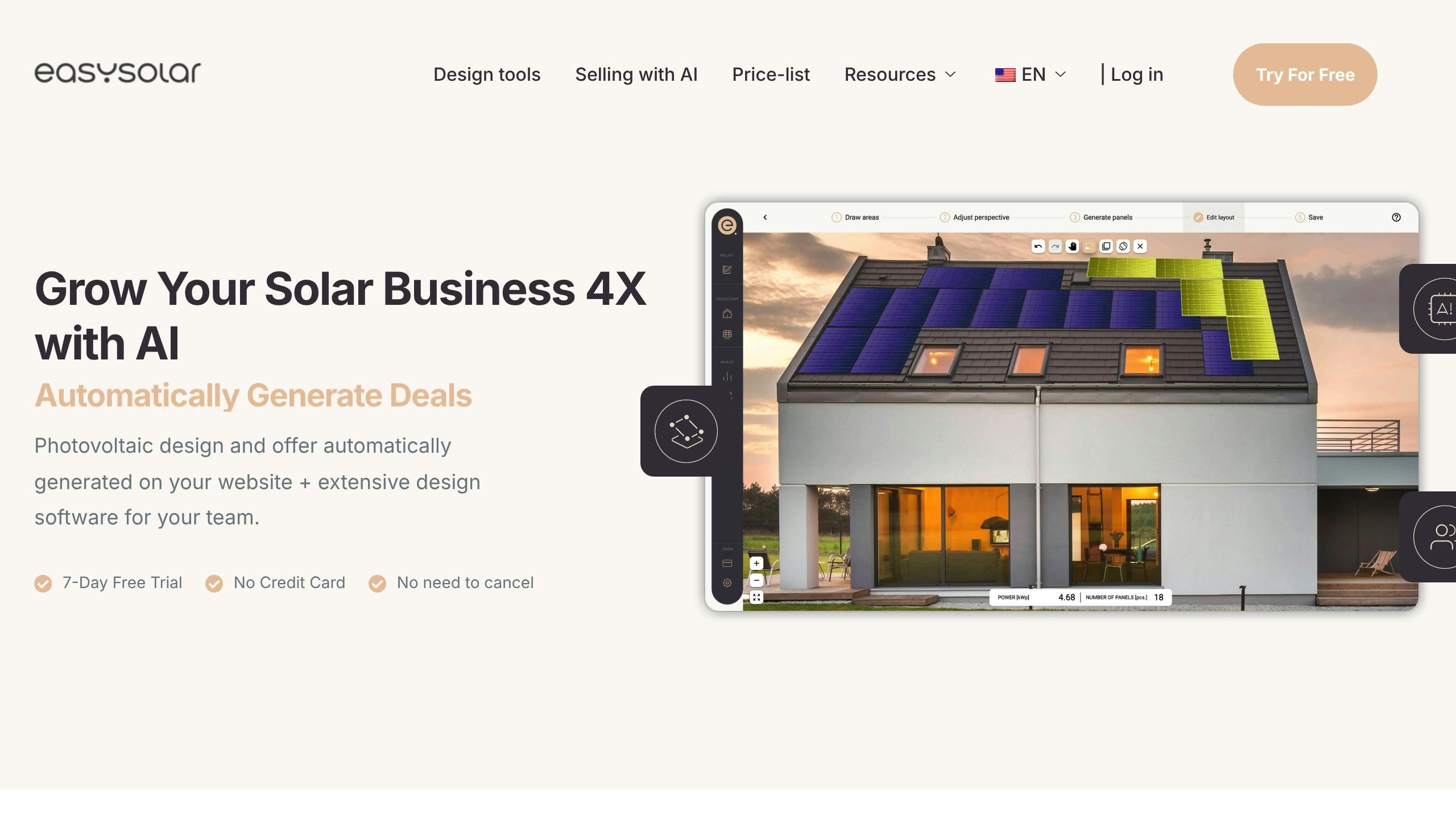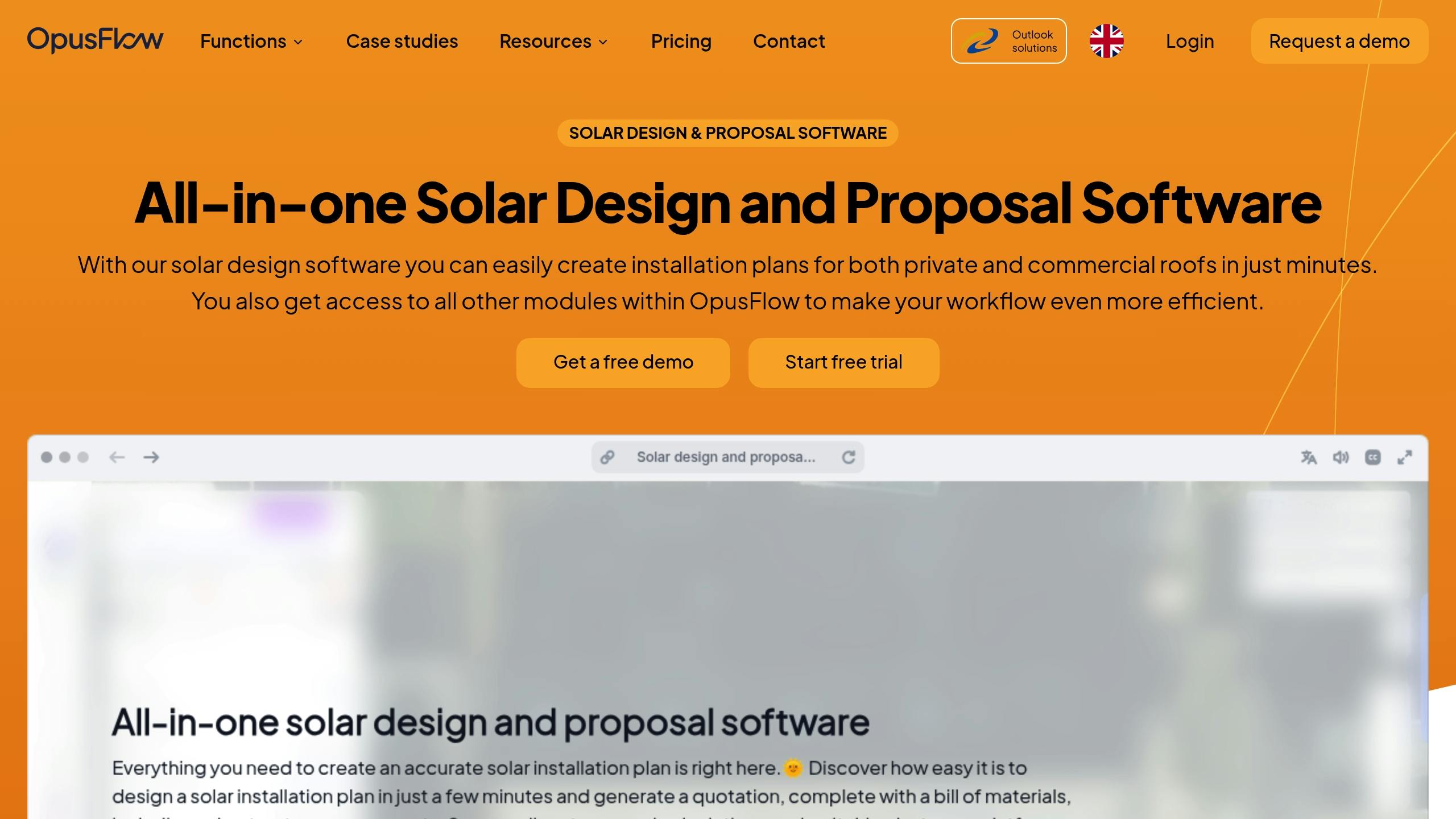Comparing 5 Leading Solar Proposal Software Options

Looking for the best solar proposal software? Here’s a quick comparison of the top 5 platforms: EasySolar, Aurora Solar, Solargraf, ARKA 360, and OpusFlow. These tools streamline solar design, financial planning, and customer engagement, saving time and improving accuracy.
Key Highlights:
- EasySolar: Uses AI, budget-friendly (€25/user/month), great for design and automated sales.
- Aurora Solar: Advanced 3D modeling, LIDAR-based precision, ideal for complex projects ($220/user/month).
- Solargraf: Fast, customizable proposals with offline features ($39-$99/month).
- ARKA 360: Strong regional compliance tools, great for specific markets (custom pricing).
- OpusFlow: Perfect for large-scale projects with multi-site management (custom pricing).
Quick Comparison Table:
| Software | Best For | Key Features | Pricing |
|---|---|---|---|
| EasySolar | design and automated sales | AI-first, design tools, customizable PDFs | €25-€35/user/month |
| Aurora Solar | Complex designs | 3D modeling, LIDAR, advanced shading tools | $220/user/month |
| Solargraf | Fast customer engagement | On-site quoting, offline mode, integrations | $39-$99/month |
| ARKA 360 | Regional compliance | Weather-based modeling, project tracking | Custom pricing |
| OpusFlow | Large-scale portfolios | AI layouts, API integrations, GDPR-ready | Custom pricing |
Choose based on your business size, budget, and project complexity. Keep reading for detailed insights into each platform.
EasySolar AI Proposal Tool
1. EasySolar

EasySolar is a cloud-based software that combines AI-driven design tools with project management features. Accessible on both mobile devices (Android and iOS) and web browsers, it allows users to easily switch between fieldwork and office tasks.
One of its key strengths is its mobile-first design. Field teams can use the mobile app for tasks like GPS-based site assessments, real-time shadow simulations, and quick layout drafting during client meetings. This enables faster customer decisions with on-the-spot visualizations.
Another highlight is EasySolar’s customizable 14-section proposal templates, which generate branded PDF documents. The platform also handles various financial scenarios, including net metering calculations and other incentive models.
| Feature Category | Capabilities |
|---|---|
| Design Tools | PV layout creation withy AI, shadow simulation,AI rooftop measurements |
| Financial Analysis | Net metering, ROI projections, incentive modeling |
| Project Management | Customizable status blocks, automated updates, search tools |
| Mobile Features | GPS integration, on-site measurements, real-time designs |
Beyond design, EasySolar streamlines workflows by automating administrative tasks, reducing delays.
Pricing is subscription-based, with two options: Basic (€25/user) and Plus (€35/user). The Plus plan includes API access and custom contract terms.
2. Aurora Solar

Aurora Solar stands out by offering advanced remote design tools powered by satellite imagery and LIDAR data, setting it apart from platforms like EasySolar, which focus more on mobile usability.
Its AI-driven remote assessments boast an impressive 95% accuracy for residential projects and 90% for commercial ones. This high level of precision minimizes the need for on-site visits while maintaining technical reliability.
| Feature Category | Key Features |
|---|---|
| Design Tools | 3D modeling, LIDAR-based design, shade analysis |
| Financial Analysis | ROI calculations, incentive modeling, utility rate database |
| Project Management | CRM integration, automated workflows |
| Remote Assessment | Satellite imagery analysis, AI-powered measurements |
Aurora Solar also excels in financial automation, keeping proposals up-to-date with real-time incentive and utility rate changes. This eliminates the hassle of manual updates and ensures accurate financial projections.
The platform offers three pricing tiers – Discover, Accelerate, and Innovate – tailored to fit businesses of different sizes. It integrates smoothly with popular CRM platforms like Salesforce and HubSpot, as well as financing tools and equipment databases. This seamless integration streamlines the entire process, from managing leads to planning installations.
Aurora Solar provides onboarding support through video tutorials, live webinars, and dedicated assistance. However, due to the platform’s advanced features, it requires more training compared to simpler solutions.
3. Solargraf

Solargraf offers a cloud-based platform designed to blend ease of use with robust functionality. It cuts proposal generation time in half, thanks to mobile features that support on-site assessments, offline designs, and instant quotes. This is especially helpful for installers who need to secure quick decisions from clients.
| Feature Category | Capabilities |
|---|---|
| Design Tools | Automated satellite-based panel placement, shade analysis |
| Mobile Features | On-site assessments, offline mode, real-time quoting for client engagement |
| Financial Tools | ROI calculations, financing options |
| Customization | White-labeling, branded templates, multi-language support |
The platform is budget-friendly, with plans starting at $39 per month for the Lite version and $99 per month for the Pro plan. Unlike Aurora Solar, which emphasizes remote precision, Solargraf stands out with its mobile-first approach, making it ideal for installers who prioritize in-person collaboration with clients.
With integrations spanning over 700 partners – including manufacturers, distributors, and financiers – Solargraf also uses machine learning to enhance panel placement with satellite imagery and weather-based production forecasts.
While it might not match Aurora Solar’s advanced design features, Solargraf compensates with simple workflows and highly customizable proposal tools. Regular software updates and responsive customer support further enhance the user experience, ensuring installers have access to the latest tools and assistance.
sbb-itb-51876bd
4. ARKA 360

ARKA 360 is a cloud-based solar proposal software that combines advanced design tools with practical, user-friendly features. Its machine learning algorithms optimize panel layouts while factoring in local weather conditions, aligning with the growing trend of AI-driven precision in solar design. Beyond its design capabilities, ARKA 360 also includes robust tools for managing projects effectively.
| Feature Category | Capabilities |
|---|---|
| Design Tools | Satellite and blueprint mapping, 3D modeling |
| Analysis Features | Solar access and shading analysis, energy simulation |
| Mobile Capabilities | On-site surveys and measurements |
| Project Management | Real-time collaboration and project tracking |
The software speeds up designs by integrating Google Maps and LiDAR data, ensuring accurate site modeling. It also simplifies financial planning by automating scenarios, incentives, and financing options, all within one platform. ARKA 360 makes proposal creation easier by allowing businesses to customize designs to reflect their branding, while still presenting technical details in a way that’s easy for clients to understand.
Its real-time collaboration tools keep design and installation teams in sync, enhancing workflow automation. With a 4.5/5 rating on Capterra and a free trial option, ARKA 360 offers a balance of technical capabilities and ease of use.
5. OpusFlow

OpusFlow stands out by focusing on businesses that need a streamlined approach to managing solar design, sales, and installation workflows. While Aurora Solar shines with its remote precision and Solargraf emphasizes mobile usability, OpusFlow is tailored for medium to large solar companies handling complex, multi-site projects. Its AI-powered layout tools bring precision to large-scale portfolios, making it a strong choice for enterprises.
| Core Capabilities | Features |
|---|---|
| Project Management | Full tracking, multi-site portfolio handling |
| Design Tools | AI-driven layout optimization |
| Financial Analysis | Various financing options, utility rate integration |
| Integration | API for custom solutions |
OpusFlow supports diverse financing models like cash payments, loans, leases, and PPAs. It also automates utility rate updates, ensuring accurate savings calculations. A key differentiator is its ability to model regional utility rate changes across entire portfolios, setting it apart from competitors.
Unlike ARKA 360’s limited CRM integrations, OpusFlow offers a customizable API, giving businesses the flexibility to adapt the platform to their specific needs. Its AI tools analyze satellite imagery and local factors to create optimal panel layouts, reportedly cutting project timelines by up to 30%.
For customer engagement, OpusFlow provides personalized energy dashboards that enhance transparency during the sales process. On the security front, it complies with SOC 2 and GDPR standards to protect user data.
Pricing is tailored to each client and includes a trial period. Regular updates are driven by user feedback to keep up with changing industry demands.
Key Advantages and Limitations
After examining the top five solar proposal software options, some clear trends appear in their strengths and drawbacks. Each platform serves specific business needs and scales differently, offering tailored solutions.
| Software | Strengths | Weaknesses |
|---|---|---|
| EasySolar | – Accepts multiple design inputs (satellite, sketches, photos)
– AI tools for sales – Customizable 14-section PDF proposals |
• Requires at least two users |
| Aurora Solar | • Detailed PV design and modeling • Accurate shading analysis |
• Expensive ($220/month/user) • Steep learning curve • May be excessive for smaller businesses |
| Solargraf | • Quick proposal creation • Reliable customer support |
• Lacks advanced design features • Occasional performance issues • Fewer integration options |
| ARKA 360 | • Strong solar simulation tools • Regional compliance for India • Excellent support |
• Limited global usability • Lacks extensive international data • Regional focus restricts features |
| OpusFlow | • Handles multi-site portfolios • Custom API options • Advanced utility rate modeling |
• Smaller market presence • Pricing details are unclear |
When comparing these tools based on the criteria outlined earlier – design accuracy, financial automation, and customer engagement – specific patterns emerge:
- Field teams benefit from mobile-first tools like EasySolar for their simplicity and flexibility.
- Complex projects requiring precision favor Aurora Solar due to its advanced modeling capabilities.
- Regional operators find ARKA 360 useful for its compliance tools tailored to specific markets, especially in India.
Three key takeaways from this comparison:
- Cost vs. Capability: EasySolar is budget-friendly for teams, while Aurora Solar justifies its higher cost for intricate projects.
- Customization Needs: Businesses needing quick, customizable proposals may lean toward Solargraf.
- Regional Focus: ARKA 360 excels in markets with specific compliance requirements, though it lacks global adaptability.
This breakdown helps businesses match their needs with the right software, balancing budget, functionality, and scale.
Summary and Recommendations
Here’s how to align software tools with specific business needs based on earlier comparisons:
For small residential solar installers (1-10 employees):
- Top pick: EasySolar (€25/user/month)
- Alternative: Solargraf ($100/month/user)
Both offer user-friendly features, though EasySolar requires at least two users.
For commercial solar developers:
- Top pick: Aurora Solar ($220/month/user)
- Alternative: ARKA 360 (custom pricing)
Aurora Solar stands out with its advanced 3D modeling and LIDAR-based tools.
Your location matters when choosing software. For example:
For European businesses:
- Top pick: OpusFlow
- Why it works: GDPR-compliant utility rate modeling
This feature supports financial automation, especially in regulated markets.
| Business Priority | Recommended Software | Key Feature |
|---|---|---|
| Cost-efficiency | EasySolar (€25/user) | AI design and sales |
| High design precision | Aurora Solar ($220/user) | LIDAR-based 3D modeling |
| Regional compliance focus | ARKA 360/OpusFlow | Automation for local incentives |
| Fast customer engagement | Solargraf | Easy-to-use interface |
When choosing a platform, keep scalability in mind. Opt for tools that can grow with your business while staying efficient in managing proposals and projects.
FAQs
What is solar proposal software?
Solar proposal software streamlines the solar sales process by using tools like AI-driven system design, financial modeling, and professional proposal creation. Platforms like EasySolar and Aurora Solar cater to various business needs with tailored features.
These tools allow for quick and accurate system designs. Key features typically include:
- Precision design capabilities
- Automated financial projections
- Integration with CRM systems
Subscription costs usually fall between $25 and $300 per month. When choosing a platform, consider factors such as:
- Mobile-friendly options for on-the-go use
- Compatibility with your existing tools
- Customizable proposal templates
- Access to training and support
Focusing on mobile usability, seamless integrations, and onboarding resources can help you find the right fit, as shown in our platform comparisons.

